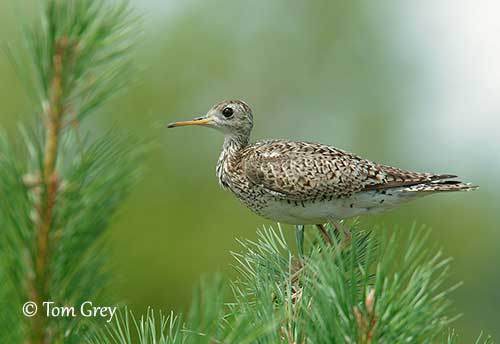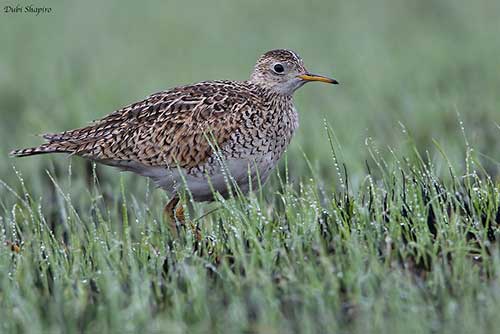
PROTECTION / THREATS / STATUS:
The Upland Sandpiper has been affected by hunting and cultivation of prairies during late 19th and early 20th centuries. The species is still abundant in some regions of the breeding range, but it also declines locally. In Pacific Northwest, it is in danger of extinction with only some small populations.
The population is estimated at 350,000 individuals, and a conservation action plan is in progress to increase the numbers through protection of the open grasslands.
However, the species is not globally threatened, and the Upland Sandpiper is currently evaluated as Least Concern.
Fr: Maubèche des champs
Ang: Upland Sandpiper
All: Prärieläufer
Esp: Correlimos Batitú
Ita: Piro piro codalunga
Nd: Bartrams Ruiter
Sd: piparsnäppa
Photographers:
Roger Ahlman
Pbase Galleries Peru and Ecuador
Tom Grey
Tom Grey's Bird Pictures & Tom Grey's Bird Pictures 2
Ken Havard
My Bird Gallery & Flickr gallery 1 & Flickr gallery 2
Dubi Shapiro
Dubi Shapiro Photo Galleries
Text by Nicole Bouglouan
Sources:
HANDBOOK OF THE BIRDS OF THE WORLD Vol 3 by Josep del Hoyo-Andrew Elliott-Jordi Sargatal - Lynx Edicions - ISBN: 8487334202
SHOREBIRDS by Peter Hayman, John Marchant and Tony Prater – Christopher Helm – 1986 – ISBN: 0747014035
THE HANDBOOK OF BIRD IDENTIFICATION FOR EUROPE AND THE WESTERN PALEARCTIC by Mark Beaman, Steve Madge - C.Helm - ISBN: 0713639601
GUIDE DES LIMICOLES de D. Taylor - Delachaux et Niestlé - ISBN : 2603014080
Department of Environmental Conservation
What Bird-The ultimate Bird Guide (Mitchell Waite)
All About Birds (Cornell Lab of Ornithology)
The Birds of North America online
Bird Web (Seattle Audubon Society)
Wikipedia, the free encyclopaedia
Upland Sandpiper
Bartramia longicauda
Charadriiformes Order – Scolopacidae Family
INTRODUCTION:
Both French and English names describe the habitat of the Upland Sandpiper. Unlike numerous shorebirds, this one is almost never on mudflats but mostly in grassland, meadows and fields where often only the upper half of the body can be seen above the grass. This North American species migrates S to South America after breeding.
The Upland Sandpiper feeds on a wide variety of insects, but it also consumes spiders, earthworms and snails, some seeds of grasses and waste grain in cultivated fields.
Following beautiful aerial displays accompanied by a rolling whistle, the Upland Sandpiper builds a nest on the ground among the grass, and breeds sometimes in loose colonies.
This species is not globally threatened and the numbers are increasing slowly. It is still fairly abundant locally in the breeding range, but it is declining in other regions. Conservation action plan is in progress.

DESCRIPTION OF THE BIRD:
Biometrics:
Length: 26-32 cm
Wingspan: 64-68 cm
Weight: 98-226 g
The Upland Sandpiper resembles Little Curlew with its long neck and small, rounded head.
The upperparts are dull olive-buff with dark brown barring and pale buff fringes. Back, rump, uppertail-coverts and central pair of rectrices are blackish-brown. Other rectrices have pale orange-buff base, brown barring and white tips.
On the upperwing, wing-coverts and tertials are dull olive-buff with dark brown barring. Primary coverts and primaries are mostly blackish-brown, whereas secondaries are paler with narrow, whitish trailing edge.
On the underparts, throat, breast and upper belly are tinged pale buff with strong brown streaking forming chevrons on lower breast and upper belly. Rest of underparts is whitish, but flanks show brown chevrons. On the underwing, coverts and axillaries are barred whitish and brown.

On the head, the crown is dark brown with some buffy streaks. The pale crown-stripe is usually indistinct. Lores, supercilium, chin and sides of face are pale buff, but the ear-coverts are slightly darker.
The bill (26-35 mm) is yellow and slightly decurved towards the tip. Tip and culmen are dark brown. The eyes are dark brown. Legs and feet are dull yellow with brownish or greenish tinge.
The female is similar but she has slightly longer wings and tail and she is 9% heavier than male.
The adults do not show seasonal variation.
The juvenile resembles adult but with scaly appearance on the upperparts. Scapulars are dark brown and flanks are less streaked.
RANGE:
The Upland Sandpiper breeds from C Alaska E to New Brunswick, Canada, and S to NE Oregon, Oklahoma and Virginia.
It winters on the pampas of South America from Brazil to Argentina.
There are records to 3,800 metres of elevation in Peru, and to almost 4,000 metres in Ecuador on migration.
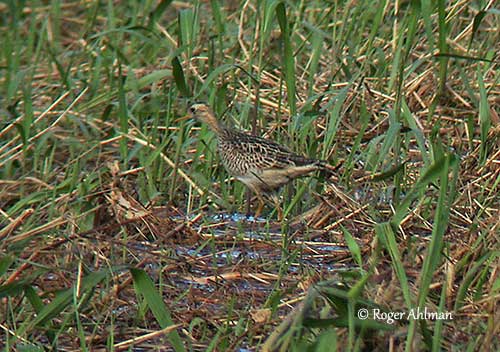
HABITAT:
The Upland Sandpiper differs from other Scolopacidae by the habitat. This species prefers open country with tall grasses, rather than wetlands and coastal habitats. It frequents mainly open prairies, grasslands, pastures and wet meadows.
On the wintering grounds, it can be seen in fairly similar habitats in pampas where it frequents both alfalfa and soybean fields. It is also found in short grass areas including airports, golf courses, and suburban lawns.
CALLS AND SONGS: SOUNDS BY XENO-CANTO
The Upland Sandpiper gives a mellow piping “quip-ip-ip-ip” in alarm and as contact call, with lower perched last syllable. We can also hear a rolling “pulip pulip”.
During the breeding season, the flight display is accompanied by song including a longer version of these calls, and “willa-willa-willa” followed by a long, drawn-out “rrrrpheeleoo”. Other short whistles can be heard too “qua-a-ily”. This species has a wide repertoire.
The Upland Sandpiper often sings from perch such as fence post, stumps or telephone poles.
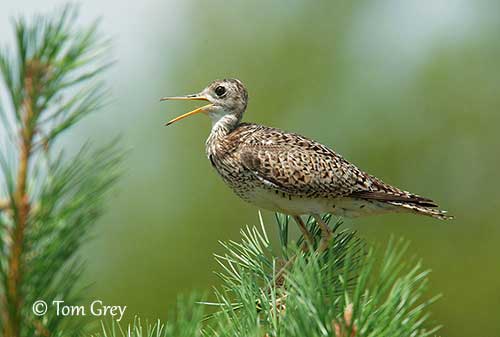
BEHAVIOUR IN THE WILD:
The Upland Sandpiper feeds on a variety of invertebrates including mainly insects such as grasshoppers, crickets, beetles (adults and larvae), moths, caterpillars and others. But is also consumes spiders, earthworms and snails. In the fields, it feeds on seeds of grasses and waste grain in cultivated areas.
The Upland Sandpiper forages alone or in small groups. It walks through grassy areas with jerky movements. Items are taken from both ground and vegetation.
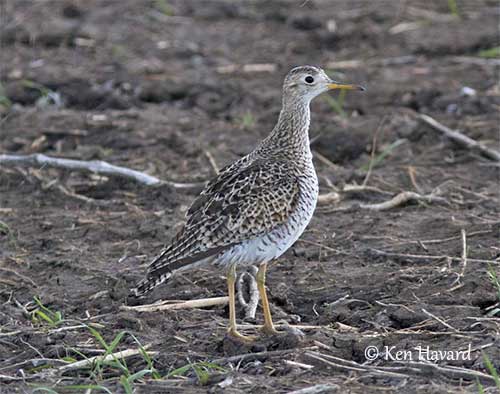
During the breeding season, it performs aerial displays over the territory while singing. It flies close to the ground, but often at great height, performing shallow, fluttering wingbeats. When landing, the wings are sometimes held high above the body.
This species nests on the ground among the dense grass, and sometimes in loose colonies.
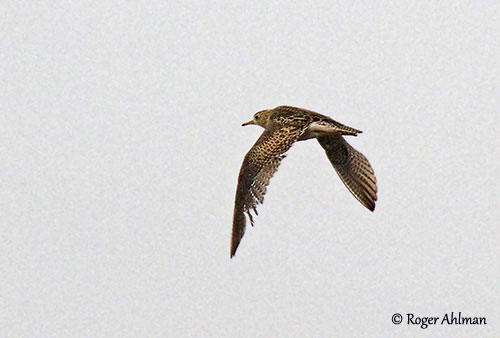
The Upland Sandpiper is a long-distance migrant and moves mainly at night. They leave the breeding grounds in late August/early September and arrive between late September and October in the wintering range.
The return migration starts mid-February, and they reach the breeding grounds in early April/June.
The species is vagrant in numerous countries of the Old World and in Australia and New Zealand.
The flight is swift and direct with rapid wingbeats.
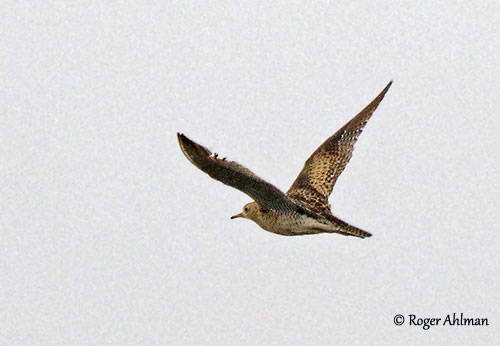
REPRODUCTION OF THIS SPECIES:
The laying occurs between early May and late June with some variations at the edge of the breeding range.
The Upland Sandpiper may sometimes breed in loose colonies. They are probably monogamous and the pairs form on the breeding grounds.
The nest is on the ground, a shallow depression among the grass. It is protected by grass arched above it. The scrape is lined with dry grass.
The female lays 4 buffy-white eggs with dark brown markings. Both adults incubate during 22-27 days. The chicks are precocial and leave the nest soon after hatching. They are able to feed themselves. They fledge about 30-31 days after hatching. They remain in the same area for ten days.
If nest or chicks are threatened by a predator, both parents perform distraction displays to lead intruders away from the nest. When the bird is frightened, it usually runs over a short distance and then, it freezes to blend into the background with help of its cryptic plumage.
